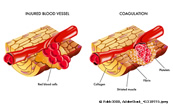The Blood Coagulation Process
Blood coagulation is the third stage of hemostasis that converts circulating substances within the blood into an insoluble gel. The gel plugs leaks in blood vessels and stops the loss of blood. The process requires coagulation factors, calcium, and phospholipids.

Mouse over to enlarge |
If the platelet plug is not enough to stop the bleeding, the platelets secrete granules that stick to proteins in the vessel wall. The platelets degranulate and release ADP (adenosine diphosphate), serotonin, and thromboxane A2 which activating more platelets.
- Platelets also release prothrombin activators that catalyze circulating prothrombin, into thrombin.
- The reaction requires Ionized calcium ( Ca++ ) that is available in the blood and from intracellular sources.
- Thrombin facilitates the conversion of a protein called fibrinogen to fibrin, forming an interlocking network of fibers and a framework for the clot.
- Platelets in the clot begin to shrink, tightening the clot and drawing together the vessel walls to initiate the process of wound healing
- Phospholipids are prominent components of cellular and platelet membranes. They provide a surface upon which the chemical reactions of coagulation can take place.
- The liver manufactures the coagulation factors (proteins).
- Either of two distinct pathways can initiate coagulation.
- The Intrinsic pathway is initiated by events that take place within the lumen of blood vessels. The Intrinsic pathway requires only elements (clotting factors, Ca++, platelet surface etc.) found within, the vascular system.
- The Extrinsic pathway is the other route to coagulation. It requires Tissue Factor (tissue thromboplastin), a substance which is "extrinsic to", or not normally circulating in the vessel. Tissue Factor is released when the vessel wall is ruptured.

Anticoagulants
Many anticoagulants prevent unnecessary coagulation, These mechanisms include:
- Protein C: a vitamin K-dependent serine protease enzyme that degrades Factor V and factor VIII.
- Antithrombin: a serine protease inhibitor that degrades thrombin, Factor IXa, Factor Xa, Factor XIa, and Factor XIIa.
- Tissue factor pathway inhibitor (TFPI): limits the action of tissue factor (TF) and the factors it produces.
- Plasmin: generated by proteolytic cleavage of plasminogen, a potent fibrinolytic that degrades fibrin and destroys clots.
- Prostacyclin (PGI2): released by the endothelium and inhibits platelet activation.
- Thrombomodulin: released by the endothelium and converts thrombin into an inactive form.
- Vitamin K is an essential factor of the coagulation cascade.
© RnCeus.com
